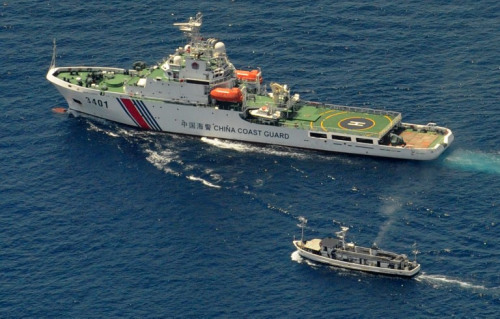

Philippine troop and Chinese maritime police boat confronted at Second Thomas Reef.
In the eyes of many international issue experts, the South China Sea is one of the hottest spots of potential conflicts in Asia. China had several intense disputes with Vietnam and Philippines over the sovereignty of islands in the South China Sea this year, while Brunei and Malaysia are also main players in the sovereignty disputes.
There are comments that the long-term territorial disputes over this sea area has made South China Sea a hotly contested spot, and countries like Vietnam and Philippines have worked hard and long to secure the islands and reefs and maritime interests they occupied.
What are their military deployments on those island and reefs? How much do they threaten China? The reporter made the following systematic analysis.
Vietnam sets up positions on nine islands and reefs
Vietnam occupied 29 islands and reefs at Nansha Islands accumulatively from the 1970s to the early1990s and has continuously fortified the defensive systems on them.
The Vietnamese military mainly adopts two defensive approaches. First, it establishes a defensive system by combining field and permanent fortifications and building both combat and living facilities. Second, it forms a defensive system by building dotted defensive facilities such as water chalets and bunkers.
The first approach is mainly applied to nine islands and reefs including Nanwei Island and Southwest Cay, where Vietnam has deployed plenty of troops because of the favorable living conditions.
Among the nine islands and reefs, Naiwei Island and Namyit Island are the catch points of the Vietnamese defensive line along the South China Sea islands and reefs, so the Vietnamese military will spare no efforts in defending them from a strategic point of view.
There are currently about 2,200 troops in the Vietnamese garrison in Nansha, equivalent to a regiment, whose main equipment includes artillery, tank, anti-tank missile and armed helicopter that can land on the islands.
However, there is no shore-to-ship missile because it requires complicated auxiliary supportive systems and permanent launching base, but almost no islands and reefs at Nansha can provide sufficient maneuvering depth.
According to pictures provided by Vietnam Pictorial, among the nine islands and reefs where Vietnam has set up positions, all of them are equipped with 23mm antiaircraft guns, six with 37mm antiaircraft guns, five with 85mm cannons, two with 122mm howitzers and 130mm cannons, six with Russia-made T-54/55 medium-sized tanks, and four with Russia-made PT-76 amphibious tanks. This amounts to over 120 artilleries of various types and more than 60 medium-sized tanks in total.
The Vietnamese military has deployed a 122mm howitzer battalion, a 85mm cannon company, a 130mm cannon company, two to three 23mm or 37mm antiaircraft artillery company and a tank company on Naiwei Island and Namyit Island respectively. Besides, at least five islands and reefs are suitable for taking off and landing of the armed helicopters.
According to Vietnam's fortifications, its artilleries, tanks and armed helicopters are basically used on the following principle during anti-landing battles.
Large-caliber artilleries will be given full play to engage in long-distance artillery fight with the enemy's surface vessels, so as to force the enemy landing force to wade through water at a far distance. Vietnam's 130mm cannon has the longest range of 27km, about the same as that of naval artillery equipped on Chinese destroyers.
Forming a firepower depth covering long, medium and short distance, the artilleries of various types can attack enemy landing forces at different distance during their passage voyage.
On Nanwei Island, for example, Vietnam deployed four artilleries with the shooting range of over 16km, 21 artilleries with the range of over 14km, 31 over 10km and 48 over 2km.
Furthermore, the Vietnamese military may dispatch armed helicopters to garrison the island or take action along with the vessels when necessary, so as to exert the maneuvering combat capability of the aviation forces.
In addition to the nine "fortress-style islands and reefs" mentioned above, other islands and reefs occupied by Vietnamese troops are "easy to attack but hard to defend" due to geographical conditions.
Therefore, the Vietnamese military only built concrete tower-shaped redoubts or even simple water chalets as garrison points and deployed man-portable light weapons there.
Vietnam's Tuoi Tre News revealed several special operation troops of the Vietnamese Navy that "are able to carry out missions in the 'East Sea'" in March 2013, including the 126th Special Operation Regiment, whose officers and men are trained in Nansha three times a year with each training lasting about a month.
During the training, they mainly learn all kinds of underwater combat skills. The 126th Fast Response Battalion formed in 2005 is also a "trump card" unit targeting the South China Sea, which aimed to become a triphibian force like the US Navy Seal.
Copyright ©1999-2018
Chinanews.com. All rights reserved.
Reproduction in whole or in part without permission is prohibited.